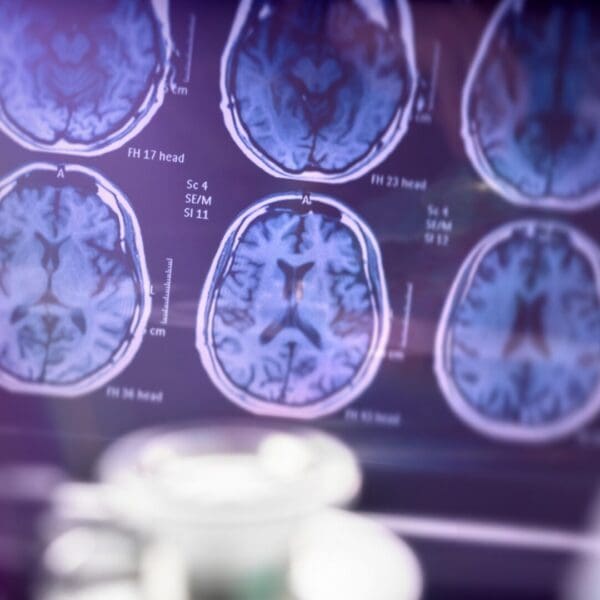You know of the supplement melatonin. You’ve likely heard that it may help you fall asleep or stay asleep. Perhaps you’ve even taken it. But did you know that melatonin has been grabbing headlines in scientific journals for its potential anti-aging properties as well? In this article I’m going to share the mounting evidence on why melatonin may play a key role in extending longevity.
What is Melatonin?
Melatonin production is primarily regulated by the pineal gland in response to darkness. As people age, the pineal gland (gut bacteria also produce some melatonin) may become less efficient, reducing hormone levels. This decline in melatonin production can result in changes in sleep patterns, such as difficulty falling asleep and staying asleep, as well as alterations in the body’s natural circadian rhythm. The exact age at which melatonin production starts to decrease can vary among individuals. Still, it generally begins around middle age, typically in the late 30s or early 40s, and continues to decline over time. This reduction in melatonin levels can contribute to age-related sleep disturbances and may be one of the factors contributing to sleep problems commonly observed in older adults. The following chart shows how our melatonin levels will decrease as we age. Melatonin’s decline seems to follow a similar pattern as NAD, HGH, and several other compounds. The following chart shows melatonin’s decline with age.
Grivas T.B., Savvidou O.D. Melatonin is the “light of night” in human biology and adolescent idiopathic scoliosis. Scoliosis. 2007;2:6. doi 10.1186/1748-7161-2-6.
The Role of Melatonin in Aging
Melatonin is a hormone secreted by the pineal gland in response to darkness. An important function is to regulate the circadian rhythm and help maintain a healthy sleep-wake cycle. However, research has revealed that melatonin’s benefits extend beyond sleep regulation. It possesses potent antioxidant, anti-inflammatory, and immunomodulatory properties, crucial in combating cellular damage, oxidative stress, and inflammation – all vital contributors to aging.
Melatonin’s antioxidative properties stem from its ability to scavenge free radicals and protect cellular components from oxidative damage. Moreover, it stimulates the activity of antioxidant enzymes, such as superoxide dismutase and glutathione peroxidase, further fortifying the body’s defense against oxidative stress.
Inflammation is a primary underlying driver of the aging process; hence we give the process the name inflammaging. By modulating immune responses and inhibiting the production of inflammatory molecules, melatonin showcases its anti-inflammatory prowess. It effectively reduces the release of pro-inflammatory cytokines, contributing to a more balanced immune system and potentially reducing the risk of age-related chronic diseases, such as cardiovascular disease and diabetes.
Intriguingly, melatonin’s effects extend beyond the cellular level. It engages with specific receptors, MT1 and MT2, in various tissues and cells throughout the body. These receptors are part of the G-protein coupled receptor (GPCR) family and are found in multiple tissues and cells throughout the body. They are crucial in mediating melatonin’s effects on different physiological processes, including sleep regulation, circadian rhythm maintenance, and other functions associated with melatonin’s potential anti-aging and regenerative properties.
The MT1 receptor, also known as the melatonin receptor type 1, is primarily found in the brain, specifically in regions such as the hypothalamus’s suprachiasmatic nucleus (SCN) – a key area for regulating the circadian rhythm. Activation of the MT1 receptor helps regulate the sleep-wake cycle by synchronizing the body’s internal clock with the external day-night process. When melatonin binds to the MT1 receptor, it signals the body that it’s nighttime, promoting feelings of drowsiness and preparing the body for sleep. Beyond sleep regulation, the MT1 receptor also plays a role in other processes, including mood regulation and neuroprotection. Activation of this receptor has been associated with improvements in mood disorders and has been studied for its potential role in protecting neurons from damage.
The MT2 receptor, or melatonin receptor type 2, is also found in the brain, particularly in areas like the hypothalamus, but it’s more widely distributed throughout the body than the MT1 receptor. The MT2 receptor regulates the sleep-wake cycle, like the MT1 receptor. Its activation contributes to the timing of sleep onset and sleep duration.
Additionally, the MT2 receptor has been linked to other processes such as immune regulation, thermoregulation (body temperature control), and possibly certain metabolic functions. This receptor’s broader distribution suggests a more widespread melatonin role beyond sleep regulation. The interaction between melatonin and its MT1 and MT2 receptors forms the foundation of the body’s circadian rhythm system. The receptors help synchronize various physiological functions to the day-night cycle, influencing not only sleep patterns but also a range of bodily processes, including hormone secretion, immune responses, and cellular repair mechanisms. The presence of these receptors in various tissues underscores the potential for melatonin to impact a wide array of bodily functions. In anti-aging and regenerative medicine, activating MT1 and MT2 receptors might contribute to melatonin’s effects on DNA repair, cellular health, and other mechanisms associated with slowing the aging process. It’s worth noting that the research into these receptors and their roles is ongoing, and scientists are continuously uncovering new insights into the complex interplay between melatonin and its receptors. This interaction triggers a cascade of events that culminate in the activation of cellular repair mechanisms, mitochondrial biogenesis, and enhanced autophagy – a process that rids cells of damaged components. These actions are crucial for maintaining cells’ and tissues’ overall health and vitality. Additionally, melatonin’s ability to regulate the expression of genes involved in immune response, DNA repair, and cellular survival is instrumental in its potential to slow down the aging process. These effects are further augmented by melatonin’s role in promoting the production of substances like brain-derived neurotrophic factor (BDNF), which supports neuronal growth, plasticity, and cognitive function.
Reasons You May Have Low Melatonin Levels
Inadequate exposure to sunlight, insufficient dietary intake, and an inconsistent bedtime routine can lead to decreased melatonin levels. Other factors include a shortage of tryptophan, engaging in shift work, experiencing jet lag, using specific medications like beta-blockers, and facing conditions that impact the brain, such as Alzheimer’s disease.
There are also concerns regarding the impact of artificial light, mainly blue light emitted by electronic devices like cell phones, TVs, Kindles, and computer screens. This light confuses the brain’s perception of darkness and may reduce melatonin production, as the brain doesn’t fully register the onset of nighttime. To address this, some electronic devices are now equipped with blue light filters or night mode settings, which help reduce exposure during times when the body should naturally release melatonin, promoting a sense of sleepiness.
Given the potential deficiency in the “darkness hormone,” is melatonin supplementation a viable option? Could its benefits extend beyond aiding sleep?
Is Melatonin the New Vitamin D?
Ongoing research suggests that there are advantages across various domains. There is now a concept in antiaging medicine that melatonin is the “new Vitamin D.” There exist notable resemblances between melatonin and vitamin D in the extensive scope of their health effects. Both function as hormones, influencing various systems through their roles in immune regulation and inflammation reduction. They are present in the skin and responsive to light exposure and changes in darkness. Parallels can be drawn between the widespread apprehension regarding vitamin D deficiency stemming from insufficient sunlight exposure and the potential decrease in melatonin secretion due to an excess of artificial blue light, often called “darkness deficiency.” The following diagram shows this concept better. We see many of their functions overlap.
Melatonin can complement and enhance various other anti-aging treatments and interventions. Its multifaceted effects on cellular health, antioxidant protection, inflammation regulation, and sleep quality make it valuable to a holistic anti-aging approach.
7 Ways Melatonin Can Benefit Other Anti-Aging Treatments
1. Combination with Antioxidant Supplements: Melatonin’s potent antioxidant properties can augment the effects of other antioxidant supplements, such as vitamins C and E, by providing additional protection against oxidative stress. Combining melatonin with other antioxidants can create a synergistic effect, further reducing cellular damage and promoting overall cellular health.
2. Synergy with Hormonal Therapies: Hormonal imbalances are often associated with aging. Melatonin’s ability to influence hormone secretion and receptor activity, especially in the context of the sleep-wake cycle, can synergize with hormonal therapies to optimize endocrine function. It may improve hormonal balance and regulation, supporting the body’s rejuvenation.
3. Amplifying Cellular Repair in Stem Cell Therapy: Stem cell therapies are being explored for their regenerative potential. Melatonin’s role in promoting DNA repair, cellular protection, and mitochondrial function can synergize with stem cell treatments by creating an environment that supports the survival and integration of newly introduced stem cells.
4. Supporting Cognitive Enhancement: As cognitive decline is a common aspect of aging, combining melatonin with cognitive-enhancing interventions like brain training exercises or nootropic supplements may offer a comprehensive approach to maintaining cognitive function and preventing neurodegenerative diseases.
5. Augmenting Skin Health Treatments: Melatonin’s antioxidant and anti-inflammatory properties can complement skincare treatments by protecting skin cells from damage caused by UV radiation and environmental toxins. Its potential to improve sleep quality indirectly contributes to skin health, as sleep is crucial for cellular repair and collagen production.
6. Enhancing Exercise and Nutrition Strategies: Melatonin’s ability to mitigate oxidative stress and inflammation can benefit individuals engaged in regular exercise, helping to counteract the oxidative damage from intense physical activity. Additionally, combining melatonin with a balanced and nutrient-rich diet can create a comprehensive approach to supporting overall health and vitality.
7. Integrating with Lifestyle Changes: Anti-aging strategies often involve lifestyle modifications. Melatonin’s sleep-enhancing properties can assist individuals in adopting healthier sleep habits, which are essential for regeneration and overall well-being. Improved sleep patterns can amplify the benefits of dietary, exercise, and stress reduction interventions.
Incorporating melatonin into existing anti-aging treatments requires careful consideration of dosages, timing, and potential interactions with other interventions. Collaboration with healthcare professionals is crucial to ensure a tailored approach that maximizes the synergistic effects of melatonin and other therapies, ultimately promoting comprehensive anti-aging benefits.
As advancements continue to reveal the complexities of melatonin’s actions, its incorporation into our anti-aging programs offers new avenues for promoting healthier aging and extending the quality of life for those seeking to embrace the fullness of their years.














